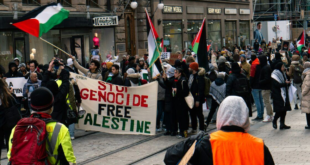GANDAMAK, Afghanistan — On a dirt road leading into Afghanistan’s White Mountains, there is a sign bearing American and Afghan flags that looks eerily out of place.
    “This project has been undertaken by the Islamic Government of Afghanistan with the financial assistance of the people of the United States of America,” it reads. The sign, which marks a defunct crop-substitution scheme, sits squarely in a field of freshly seeded Afghan poppies, whose deadly buds produce 90 percent of the world’s high-grade heroin.
    Afghanistan is about to produce another bumper crop of opium, and narcotics specialists predict another major increase over last year’s 60 percent rise in poppy cultivation. The number of Afghans involved in the illicit trade, either as farmers or dealers, rose last year from 2 million to nearly 3 million people, according to State Department figures released this month.
    That means that more than 12 percent of the population has a hand in drug production or trafficking at some level.
    Government officials and tribal leaders have tried to oppose the burgeoning drug trade and are growing increasingly frustrated.
    “I have been preaching against the poppy for years,” said Malik Musafir Poparzai, a tribal leader and village headman. “My people listened last year, but everyone in nearby villages grew poppies and made money and my people now insist they need the money too.”
    A glance over his shoulder reveals field after field of terraced seedlings sown in a remote corner of eastern Afghanistan, which for security reasons is off-limits to most Western officials.
    Ministry corrupted
    Mr. Poparzai, who has 12 children, said Taliban and al Qaeda fighters sometimes come down from the White Mountains at night and encourage the local farmers to protect “what is theirs” from anyone who seeks to eradicate their crops.
    But the tribal elder, echoing a growing consensus among Western diplomats and anti-narcotic specialists, said that most of the profits fall into the hands of corrupt officials in the Western-backed government of President Hamid Karzai.
    “The Ministry of Interior has become deeply corrupted,” said a Western diplomat in Kabul. “There is a new attitude of ‘Let’s make as much as we can while the poppy boom lasts,’ and it has gotten to the point where key government posts are bought and sold depending where they are located along the drug-trafficking routes.”
    Afghanistan’s minister for counternarcotics, Habibullah Qaderi, agreed in an interview that government corruption is rampant. “It goes all the way up through the Ministry of Interior and it needs to be addressed,” he said.Â
 Tom Schweich, Washington’s principal deputy assistant secretary for international narcotics, said in Vienna this month that the Afghan “drug trade is causing tremendous amounts of political corruption.”
    And while Western officials often stress ties between terrorism and narcotics and the Taliban’s involvement in protecting Afghan farmers, Afghans familiar with the production and trafficking say that this view is misleading.
    “This government has long since been hijacked by drug traffickers,” said an Afghan government official who works daily to combat the drug trade. “Even with millions of dollars, you’ll never make a dent in the problem because the problem is in the engine, not with the driver.”
    The same official serves as a “mole” for the U.S. Drug Enforcement Agency (DEA), helping to root out corruption at high levels. He said it is a poorly held secret in government enforcement circles that one of Mr. Karzai’s brothers is profiting greatly from the drug trade.
    Laboratories hidden
    Seeds are sown and deals are spun early every year in remote districts such as the Huggani district of Nanghahar province, where assassinations and intimidation are commonplace. Six district officials were mysteriously killed here last year, and local farmers rose up when the government sent tractors to eradicate the poppies this year, pummeling officials with stones and killing one of them.
    The sincerity of the government’s counternarcotics efforts is also in question. Basic economics dictates that a limited amount of eradication and interdiction helps keep the supply in line with international demand, boosting prices, said one Western diplomat in Kabul.
    A midlevel government official, speaking on the condition of anonymity, said that tens of thousands of dollars have been paid to local warlords in Huggani to “protect” production facilities, or heroin processing laboratories, which are often hidden in mud homes. He estimated that Nanghahar alone has some 300 heroin refineries, of which about 25 percent were recently destroyed.
    The DEA is alarmed at the local failures to fight production and processing. The State Department reported in March that “an increasing share of Afghanistan’s opium is refined into morphine base and heroin in Afghanistan.”
    The DEA attempts, along with its Afghan partners, to target and seize high-grade heroin within the country’s borders. In 2005, 12,330 pounds of heroin were seized, and last year, there were 4,250 pounds of drugs confiscated through September.
    The U.S. and British governments are helping to train a staff of more than 1,000 officers in a new Criminal Justice Task Force. But this has not yet led to a spike in significant prosecutions.
    “Traffickers are often caught but released from Afghan custody very quickly, and this is a critical failure,” said a U.S. diplomat.
Check Also
Can Israel Survive Without the West? The Answer Reveals Our Collective Power
The Israeli genocide in Gaza, along with the escalating regional wars it has ignited, has …
 Eurasia Press & News
Eurasia Press & News

